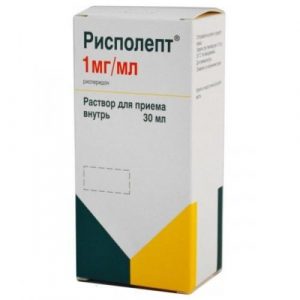Description
Pharmacological action
Pharmacodynamics: Quetiapine is an atypical antipsychotic drug.
Quetiapine and its active metabolite, N-desalkylquetiapine (norquetiapine), interact with a wide range of brain neutrotransmitter receptors. Quetiapine and N-desalkylquetiapine exhibit a high affinity for 5HT2-serotonin receptors and D1 and D2-dopamine receptors in the brain. Antagonism to these receptors, combined with a higher selectivity for 5HT2-serotonin receptors than for D2-dopamine receptors, leads to clinical antipsychotic properties with affinity for 5HT1A-serotonin receptor, while N-desalkylquetiapine exhibits high affinity. Inhibition of the norepinephrine transporter and partial agonism towards 5HT1A-serotonin receptors, manifested by N-desalkylquetiapine, may cause an antidepressant effect. Quetiapine and N-desalkylquetiapine have a high affinity for histamine and 1-adrenergic receptors and moderate affinity for 2-adrenergic receptors.
In addition, quetiapine does not have or has a low affinity for muscarinic receptors, while N-desalkylquetiapine exhibits moderate or high affinity for several subtypes of muscarinic receptors, with which anticholinergic (muscarinic-like) effects may be associated.
In standard tests, quetiapine exhibits antipsychotic activity. The specific contribution of the metabolite of N-desalkylquetiapine to the pharmacological activity of quetiapine has not been established. The results of a study of extrapyramidal symptoms (EPS) in animals revealed that quetiapine causes mild catalepsy in doses that effectively block D2 receptors. Quetiapine causes a selective decrease in the activity of mesolimbic A10-dopaminergic neurons in comparison with A9-nigrostriate neurons involved in motor function.
Effectiveness
Quetiapine is effective against both positive and negative symptoms of schizophrenia. Quetiapine is effective as monotherapy for manic episodes of moderate to severe severity.
There is no evidence of prolonged use of quetiapine for the prevention of subsequent manic and depressive episodes.
Data on the use of quetiapine in combination with valproate semisodium or lithium preparations for manic episodes of moderate to severe severity are limited, however, this combination therapy was generally well tolerated.
In addition, quetiapine at a dose of 300 mg and 600 mg is effective in patients with moderate to severe severity bipolar disorder type I and II. At the same time, the effectiveness of quetiapine when taken at a dose of 300 mg and 600 mg per day is comparable.
Quetiapine is effective in patients with schizophrenia and mania when taking the drug 2 times a day, despite the fact that the half-life of quetiapine is about 7 hours. The effect of quetiapine on 5HT2 and D2 receptors lasts up to 12 hours after taking the drug.
When taking quetiapine with a dose titration in schizophrenia, the incidence of EPS and the concomitant use of m-anticholinergic blockers were comparable to those with placebo. With the appointment of quetiapine in fixed doses from 75 to 750 mg / day for patients with schizophrenia, the incidence of EPS and the need for concomitant use of m-anticholinergic drugs did not increase.
When quetiapine was used in doses of up to 800 mg / day for the treatment of moderate to severe manic episodes, both as monotherapy and in combination with lithium preparations or semisodium valproate, the incidence of EPS and the concomitant use of m-anticholinergic blockers was comparable to that for taking a placebo.
Indications
Treatment of acute and chronic psychoses, including schizophrenia.
Treatment of manic episodes in the structure of bipolar disorder. Treatment of moderate to severe depressive episodes in the structure of bipolar disorder.
The drug is not indicated for the prevention of manic and depressive episodes.
Contraindications
Hypersensitivity to any component of the drug.
Co-administration with cytochrome P450 inhibitors such as azole antifungals, erythromycin, clarithromycin and nefazodone, as well as HIV protease inhibitors.
Children under 18 years of age (efficacy and safety not established).
Lactose intolerance, lactase deficiency, glucose-galactose malabsorption.
Caution: In patients with cardiovascular and cerebrovascular diseases or other conditions predisposing to arterial hypotension, advanced age, liver failure, a history of seizures, the risk of stroke and aspiration pneumonia.
Use in pregnancy and lactation
Pregnancy
Safety and effectiveness of quetiapine in pregnant women have not been established. Therefore, during pregnancy, quetiapine can only be used if the expected benefit for the woman justifies the potential risk to the fetus.
When using antipsychotic drugs, including quetiapine, in the third trimester of pregnancy, newborns are at risk of developing adverse reactions of varying severity and duration, including EPS and / or withdrawal syndrome. Excitement, hypertension, hypotension, tremor, drowsiness, respiratory distress syndrome, or feeding disorders have been reported. In this regard, the condition of newborns should be carefully monitored.
Breastfeeding period
Quetiapine is excreted in breast milk, but the degree of excretion has not been established. Women should be advised to avoid breastfeeding while taking quetiapine.
Special instructions
Use with caution in patients with cardiovascular diseases and other conditions associated with the risk of arterial hypotension, especially at the beginning of treatment and in the elderly with a history of seizures.
Quetiapine undergoes active metabolism in the liver. In patients with impaired liver and kidney function, the clearance of quetiapine is reduced by approximately 25%. Therefore, quetiapine should be used with caution in patients with impaired liver and / or kidney function.
Use with caution simultaneously with drugs, lengthening the QT interval (especially in the elderly) with drugs that have a depressing effect on the central nervous system, as well as with ethanol with potential inhibitors of the isoenzyme CYP3A4 (including ketoconazole, erythromycin).
With development during treatment with CNS, quetiapine should be discontinued and appropriate treatment prescribed.
With prolonged use, there is a likelihood of developing tardive dyskinesia. In such cases, it is necessary to reduce the dose of quetiapine or cancel it.
Use with caution in combination with other drugs that affect the central nervous system, as well as with ethanol.
In experimental studies of the carcinogenicity of quetiapine, an increase in the incidence of mammary adenocarcinomas in rats was observed (at doses of 20, 75 and 250 mg / kg / day), which is associated with prolonged hyperprolactinemia.
Male rats (250 mg / kg / day) and mice (250 and 750 mg / kg / day) showed an increase in the incidence of benign adenomas from thyroid follicular cells, which was associated with a known, rodent-specific mechanism for increasing hepatic thyroxine clearance .
Effect on the ability to drive vehicles and control mechanisms
Quetiapine can cause drowsiness, therefore, patients are not recommended to perform work related to the need for concentration and high speed of psychomotor reactions (including driving vehicles).
Composition
Active ingredient: quetiapine fumarate 230,260 mg in terms of quetiapine 200,000 mg.
Excipients (core): microcrystalline cellulose – 146,140 mg lactose monohydrate – 41,400 mg povidone type K-17 – 20,000 mg sodium carboxymethyl starch (primogel) – 36,000 mg calcium hydrogen phosphate dihydrate – 20,000 mg magnesium stearate – 6,200 mg.
Film coating: VTVACOAT ® PA-3P-261 finished film coating system – 12.500 mg [hypromellose (HPMC) 6 / E464 – 4.875 mg, titanium dioxide / E 171-3.729 mg, polydextrose / E1200 – 1.875 mg, talc / E553b – 1.250 mg, macrogol 3350 – 0.750 mg, iron dye oxide red / E172 – 0.021 mg].
Dosage and Administration
Inside, regardless of food intake.
Treatment of acute and chronic psychoses, including schizophrenia
Quetiapine is prescribed twice a day. The daily dose for the first 4 days of therapy is: 1st day – 50 mg, 2nd day – 100 mg, 3rd day – 200 mg, 4th day – 300 mg. Starting on day 4, the dose should be titrated to effective, usually in the range of 300 to 450 mg / day.
Depending on the clinical effect and individual tolerance of the drug to the patient, the dose can vary from 150 to 750 mg / day.
The maximum recommended daily dose is 750 mg.
Treatment of manic episodes in the structure of bipolar disorder
Quetiapine is used as monotherapy or as an adjuvant therapy to stabilize mood.
Quetiapine is prescribed twice a day. The daily dose for the first 4 days of therapy is: 1st day – 100 mg, 2nd day – 200 mg, 3rd day – 300 mg, 4th day – 400 mg.
In the future, by the 6th day of therapy, the daily dose of the drug can be increased to 800 mg. The increase in the daily dose should not exceed 200 mg per day. Depending on the clinical effect and individual tolerance, the dose can vary from 200 to 800 mg / day. Typically, an effective dose is 400 to 800 mg / day.
The maximum recommended daily dose is 800 mg.
Treatment of depressive episodes in the structure of bipolar disorder
Quetiapine is prescribed once a day at night. The daily dose for the first 4 days of therapy is: 1st day – 50 mg, 2nd day – 100 mg, 3rd day – 200 mg, 4th day – 300 mg. The recommended dose is 300 mg / day.
The maximum recommended daily dose is 600 mg. There was no clinical improvement with increasing doses of more than 600 mg / day.
To maintain remission, it is advisable to use the lowest dose.
Patients should be periodically examined to determine the need for maintenance therapy.
When resuming therapy less than 1 week after discontinuation, administration can be continued at a dose adequate for maintenance therapy.
When resuming therapy in patients who have not received quetiapine for more than 1 week, follow the rules of the initial dose selection and establish the effective dose according to the clinical response of the patient.
In elderly patients, the initial dose of quetiapine is 25 mg / day. The dose should be increased daily by 25-50 mg to achieve an effective dose, which is likely to be less than in young patients.
In patients with hepatic insufficiency, it is recommended to start therapy with 25 mg / day. It is recommended to increase the dose daily by 25-50 mg until an effective dose is achieved.
Side effects
From the side of the central nervous system: headache, drowsiness, dizziness, anxiety rarely – central nervous system.
From the cardiovascular system: orthostatic hypotension, tachycardia, arterial hypertension.
From the digestive system: constipation, dry mouth, dyspepsia, diarrhea, transient increase in the activity of liver enzymes (ALT, AST, GGT), abdominal pain.
From the side of hematopoietic organs: asymptomatic leukopenia and / or neutropenia rarely – eosinophilia.
From the musculoskeletal system: myalgia.
From the respiratory system: rhinitis.
Dermatological reactions: skin rash, dry skin.
On the part of the organ of hearing: pain in the ear.
From the genitourinary system: urinary tract infections.
On the part of the metabolism: a slight increase in cholesterol and triglycerides in the blood.
From the endocrine system: a small dose-dependent reversible decrease in the level of thyroid hormones (in particular, total and free T4).
Other: asthenia, lower back pain, weight gain, fever, chest pain
Drug interaction
When used simultaneously with ketoconazole, erythromycin, it is theoretically possible to increase the concentration of quetiapine in blood plasma and the development of side effects.
With simultaneous use with phenytoin, carbamazepine, barbiturates, rifampicin, the clearance of quetiapine increases, its concentration in the blood plasma decreases.
With simultaneous use with thioridazine, an increase in the clearance of quetiapine is possible.
Overdose of
Fatal outcome was reported with 13.6 g of quetiapine in a patient who participated in the clinical trial, as well as death after taking 6 g of quetiapine in a post-marketing study of the drug. In the same time, a case of taking quetiapine in a dose exceeding 30 g without a fatal outcome is described. There are reports of extremely rare cases of an overdose of quetiapine, leading to an increase in the QTc interval, death or coma.
In patients with a history of severe cardiovascular disease, the risk of developing side effects with an overdose may increase.
Symptoms noted in case of overdose were mainly the result of increased known pharmacological effects of the drug, such as drowsiness and sedation, tachycardia, decreased blood pressure and anticholinergic effects.
Storage conditions
In the dark place at a temperature of no higher than 25 ° C.
Keep out of the reach of children.
Expiration
3 years.
Deystvuyuschee substances
quetiapine
pharmacy terms and conditions for prescription
Form of Treatment
tablets




